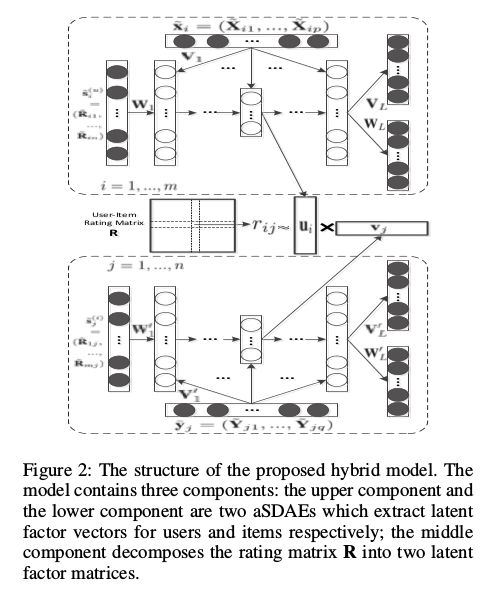作者论文PPT讲解 http://www.afenxi.com/post/42165
个人理解:
首先看看本文如何使用了DP(NN) 此思想完全继承于AutoEncoder机制(DAE: Denoising AutoEncoder), 即将一个向量编码成一个低维向量(隐向量),再还原成一个近似向量(一般用这个近似向量就可以估计用户对物品的评分,如http://nuoku.vip/users/2/articles/86 , 但本文的核心却是这个隐向量,它是一个桥梁)
融合side information 关键点在于隐向量的学习,也就是让评分矩阵的行向量或者列向量同user side information或者item side information向量一起约束学习这个隐向量
融合MF 将MF的常规表达直接加入到object function当中,不过需要注意的是,MF当中的U_u和V_v变成了上述说的隐向量
整体framework如下图:

另补充说明, 所谓的Denoising AutoEncoder (DAE), 指的是在原向量中加入噪音(如何加,本文引用文献中有说明)然后将加噪音后的向量作为输入向量,不过回复向量依旧是原向量.
| 文献题目 | 去谷歌学术搜索 | ||||||||||
| A Hybrid Collaborative Filtering Model with Deep Structure for Recommender Systems | |||||||||||
| 文献作者 | Xin Dong, Lei Yu, Zhonghuo Wu, Yuxia Sun, Lingfeng Yuan, Fangxi Zhang | ||||||||||
| 文献发表年限 | 2017 | ||||||||||
| 文献关键字 | |||||||||||
| Deep learning ; DAE; AutoEncoder; MF: CF | |||||||||||
| 摘要描述 | |||||||||||
| Collaborative filtering(CF) is a widely used approach in recommender systems to solve many real-world problems. Traditional CF-based methods employ the user-item matrix which encodes the individual preferences of users for items for learning to make recommendation. In real applications, the rating matrix is usually very sparse, causing CF-based methods to degrade significantly in recommendation performance. In this case, some improved CF methods utilize the in- creasing amount of side information to address the data sparsity problem as well as the cold start problem. However, the learned latent factors may not be effective due to the sparse nature of the user-item matrix and the side information. To address this problem, we utilize advances of learning effective representations in deep learning, and propose a hybrid model which jointly performs deep users and items’ latent factors learning from side information and collaborative filtering from the rating matrix. Extensive experimental results on three real-world datasets show that our hybrid model out- performs other methods in effectively utilizing side information and achieves performance improvement. | |||||||||||